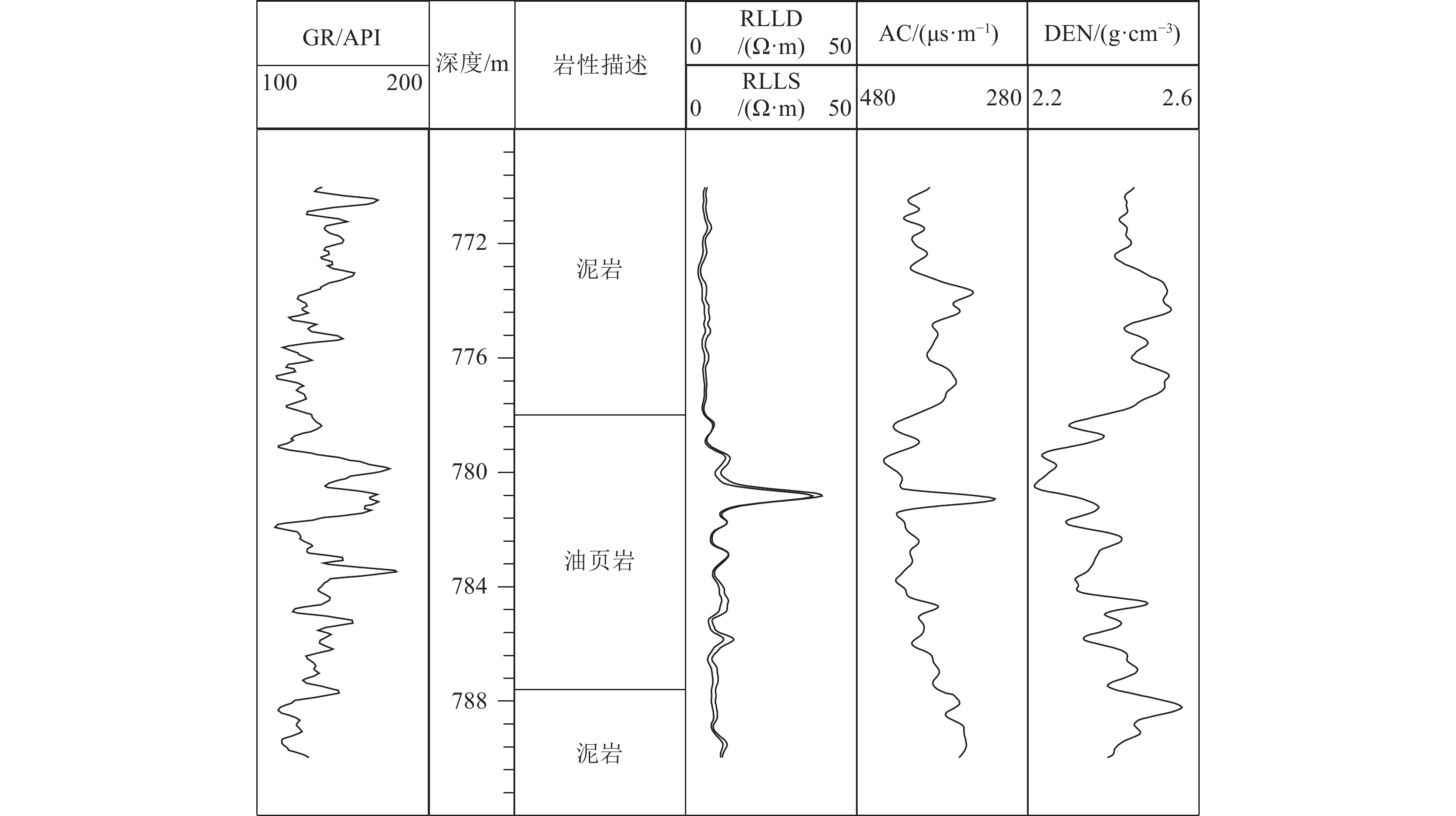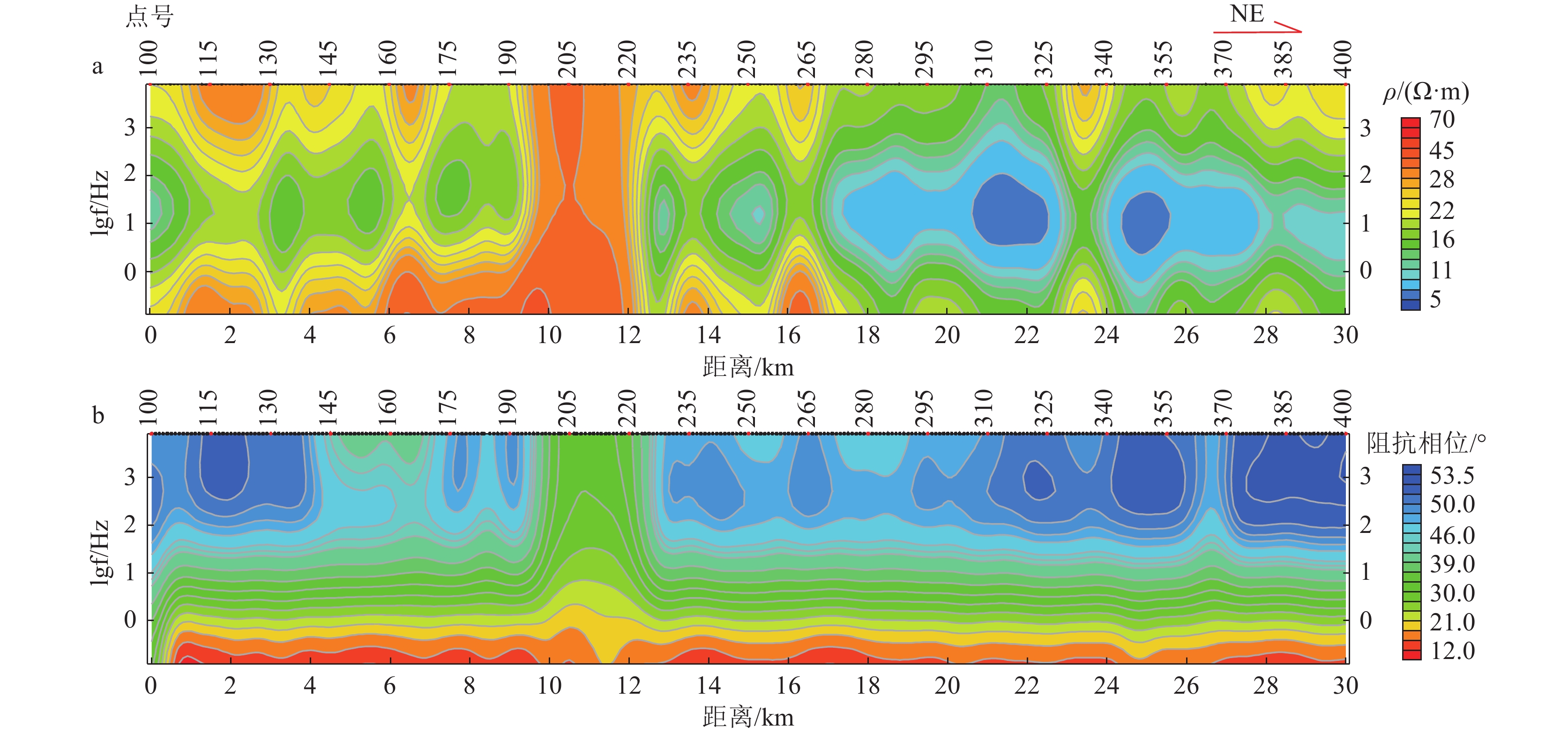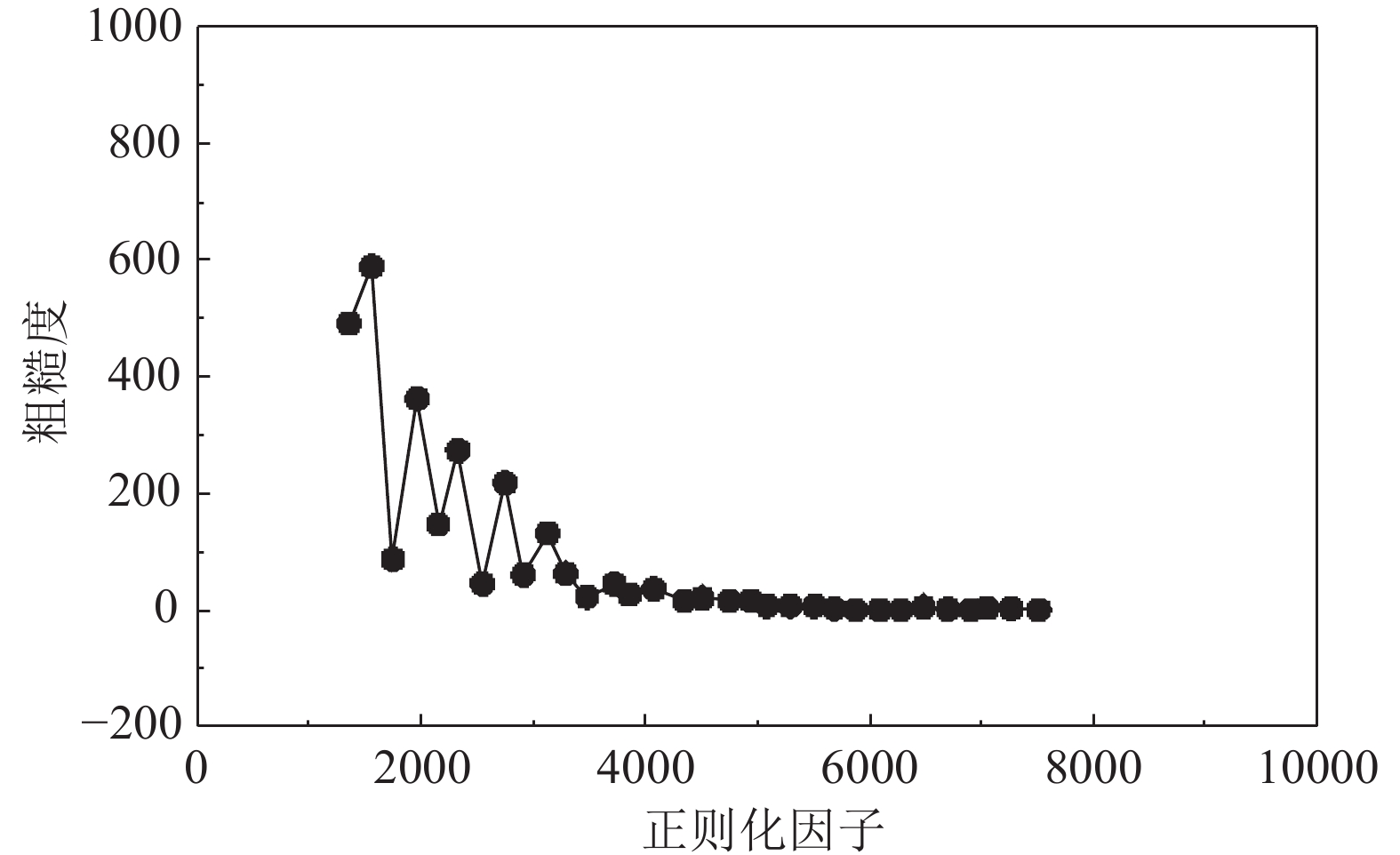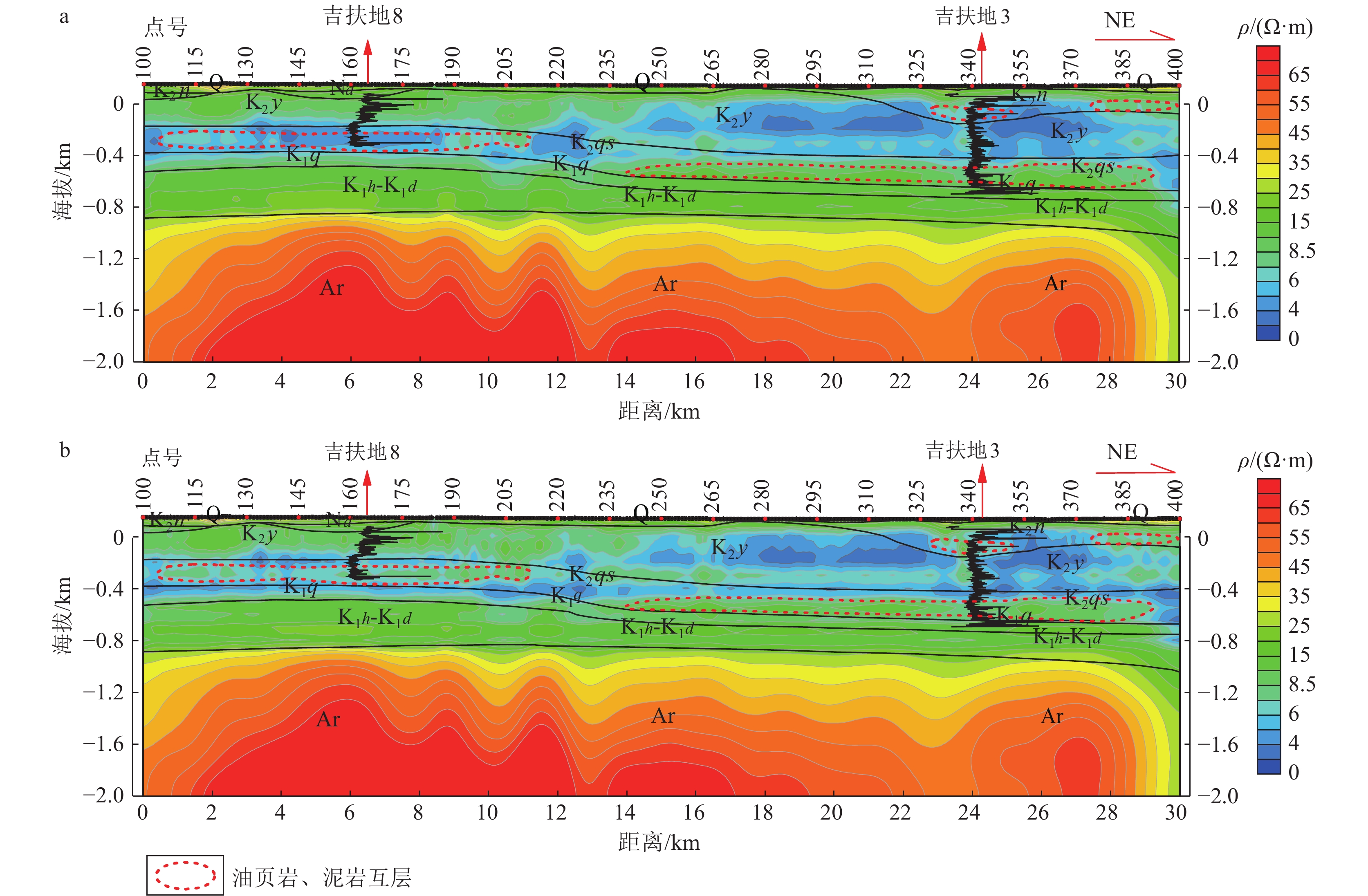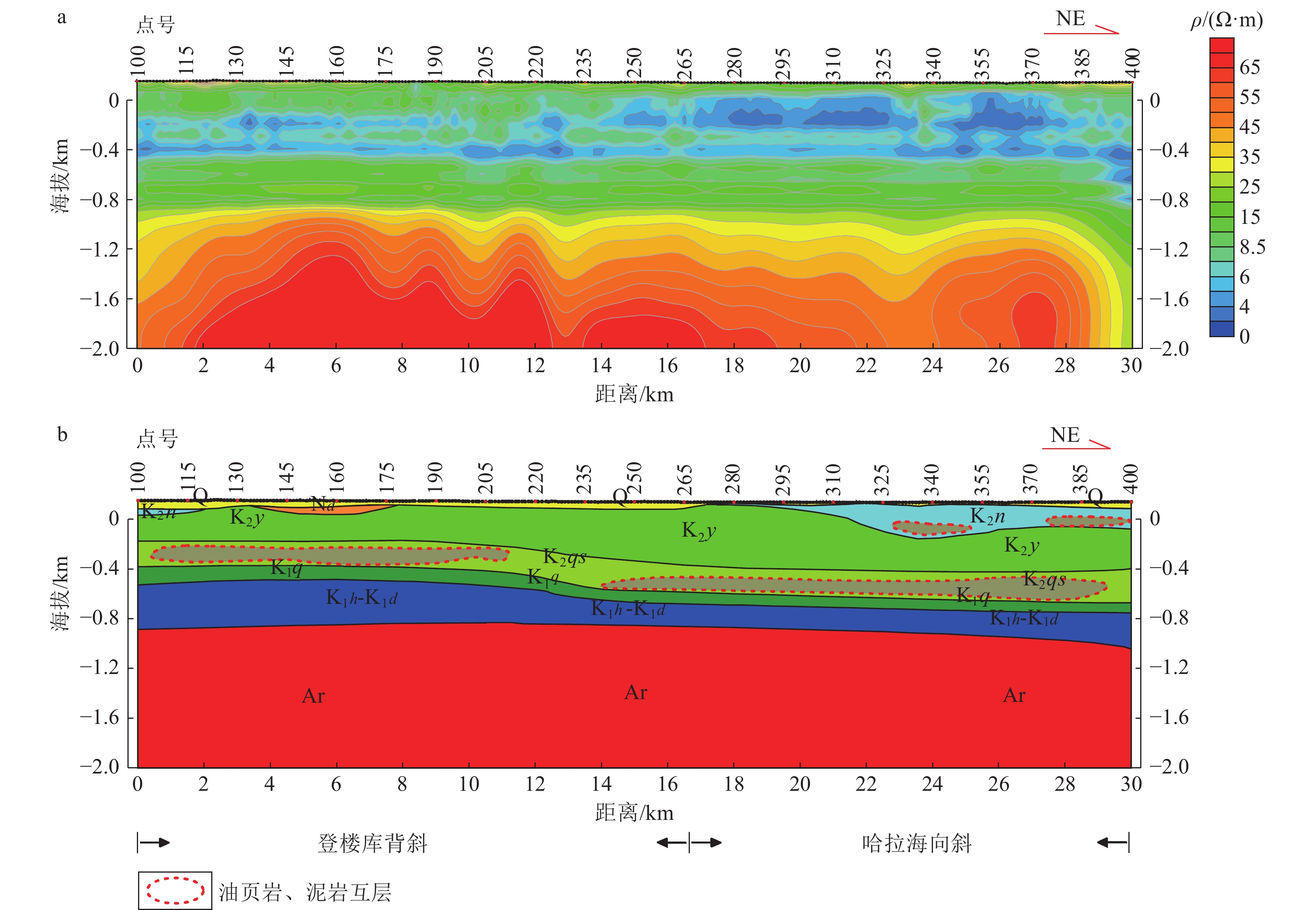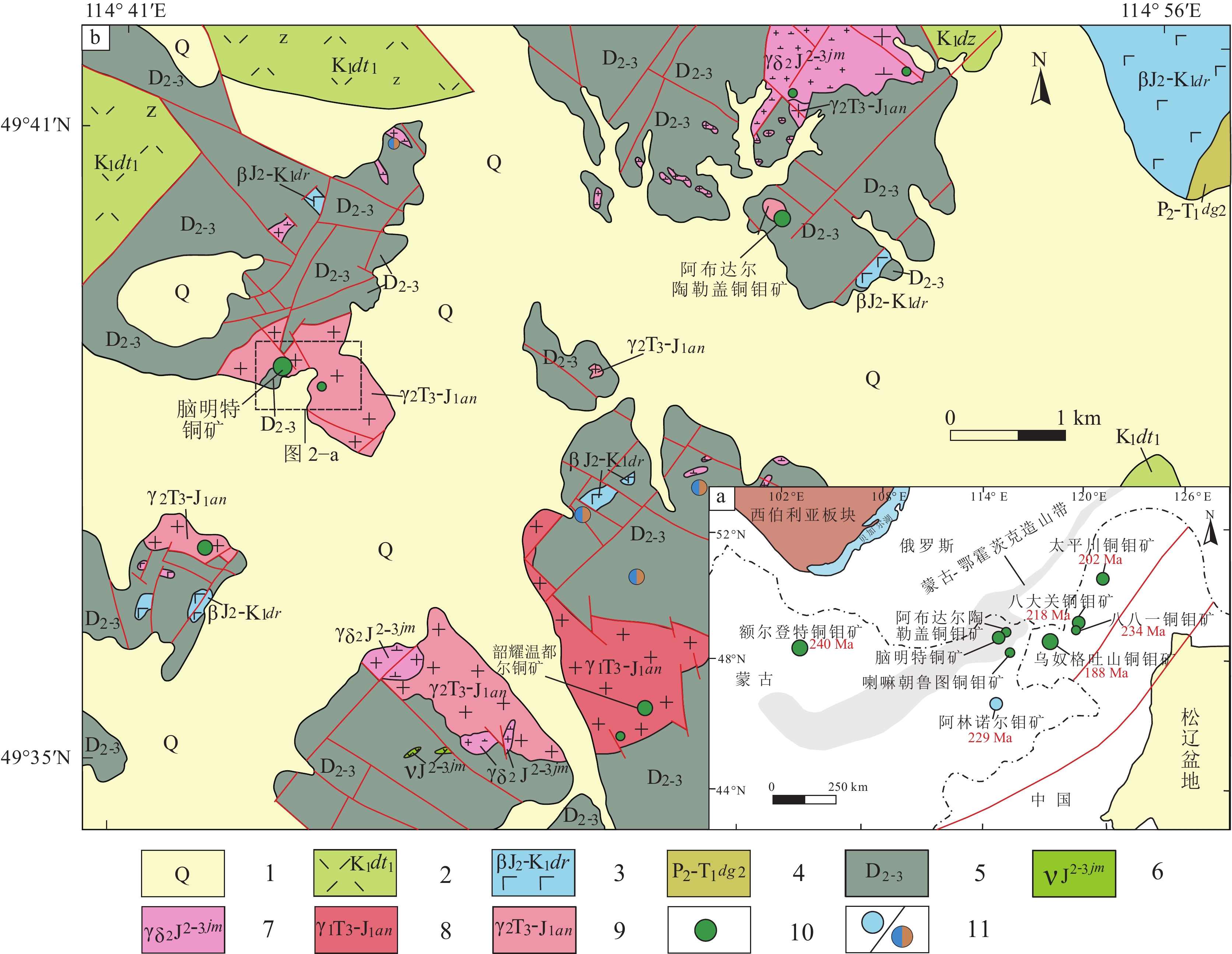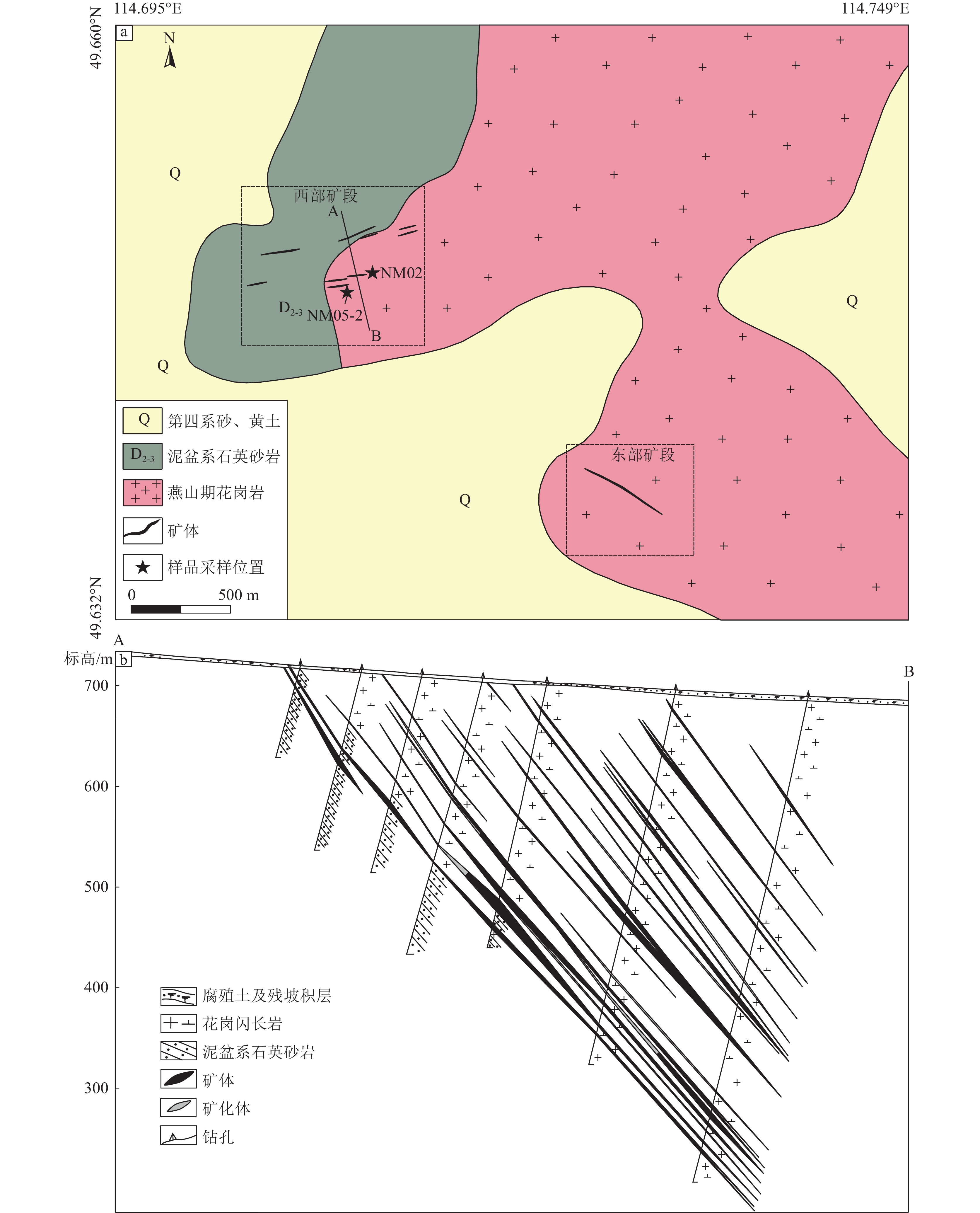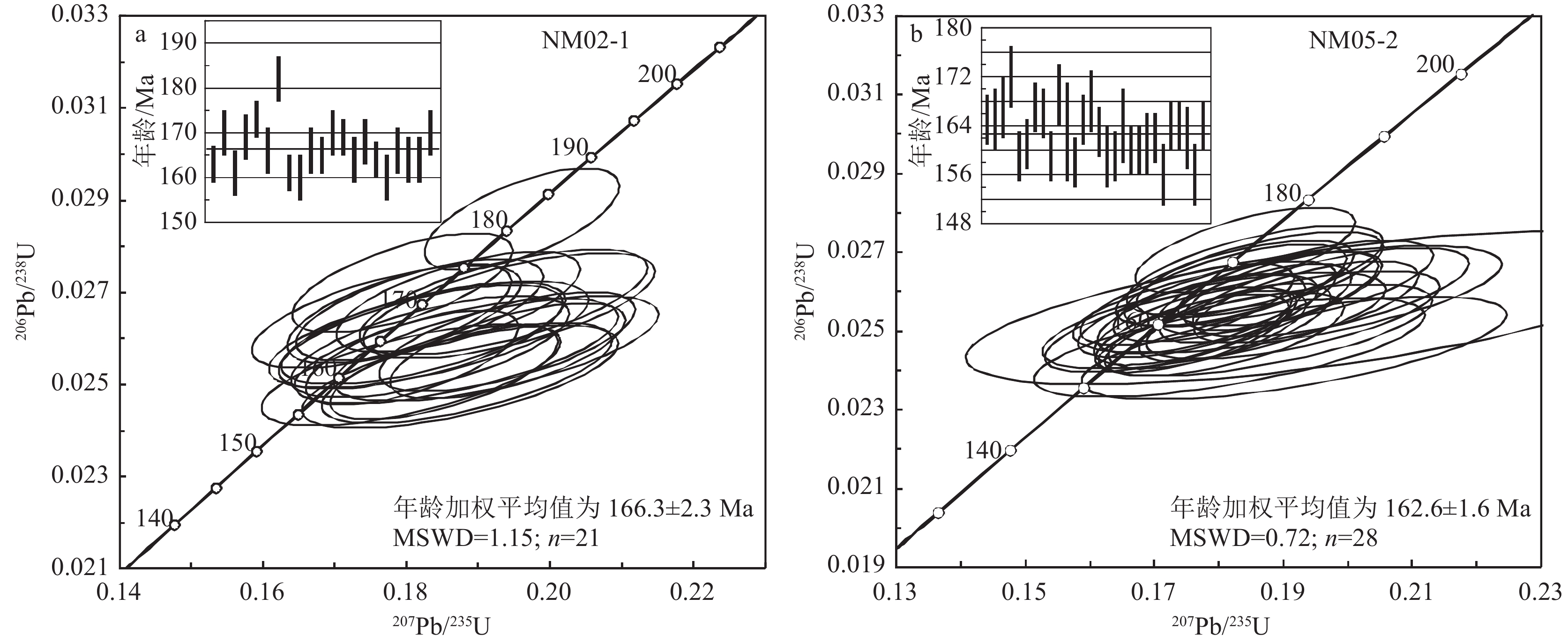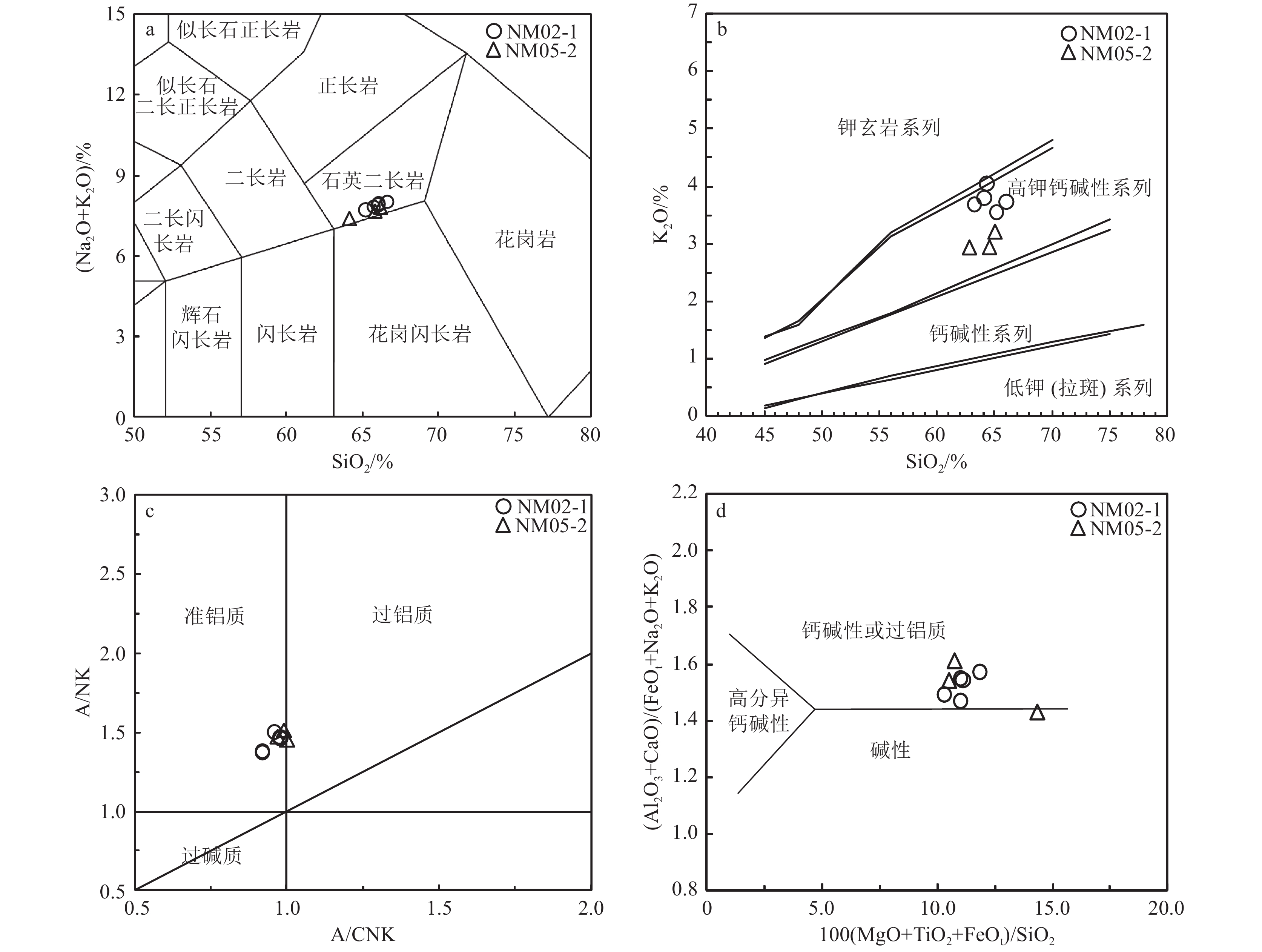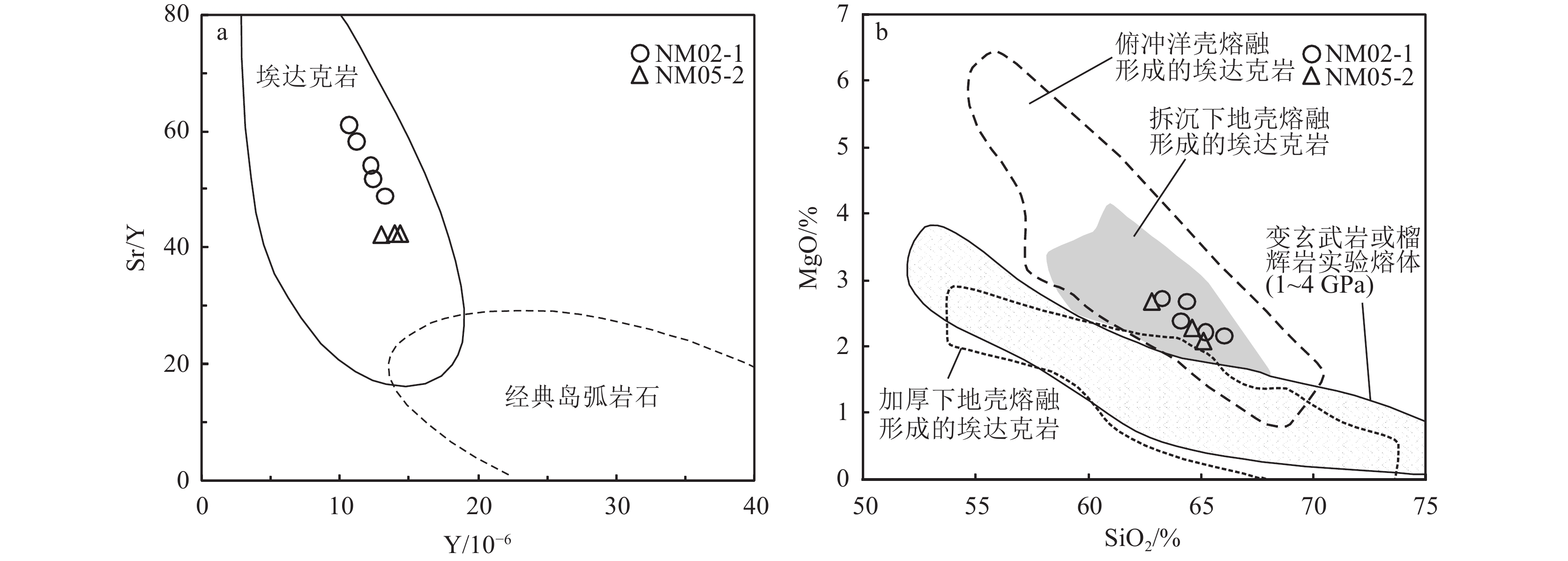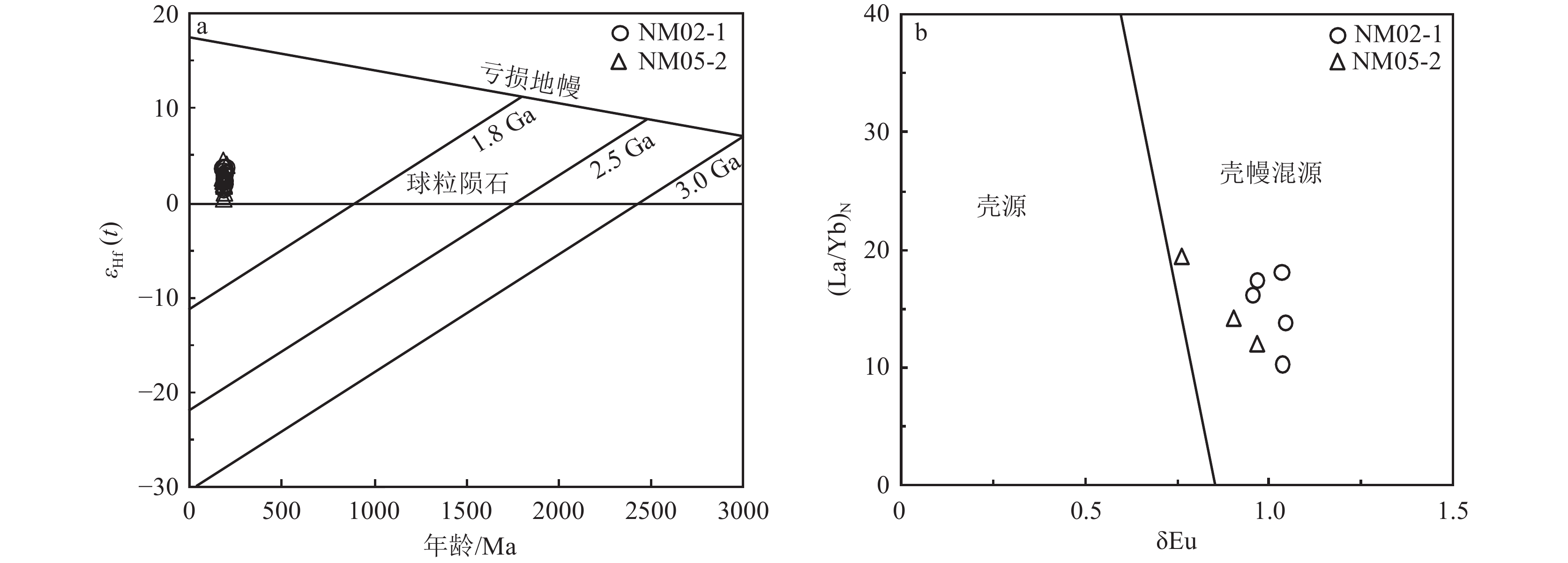Geochronology, Hf isotope, geochemical characteristics of the metallogenic rock mass in Nomint copper deposit, Northeastern Mongolia, and its constraint on metallogenic tectonic setting
-
摘要:
脑明特中型铜矿床位于蒙古−鄂霍茨克缝合带中部,是蒙古国东北部已知规模最大的铜矿床。为探究岩体与成矿的关系,在矿床学研究的基础上,对该矿床成矿岩体开展了锆石U−Pb年代学、微量元素及Hf同位素地球化学研究。结果显示:成矿岩体的锆石U−Pb年龄为166.3±2.3 Ma和162.6±1.6 Ma,表明该成矿岩体应为中侏罗世晚期岩浆作用的产物;岩石化学组成上,成矿岩体主量元素SiO2(62.81% ~ 66.03%)>56%,Al2O3(15.01% ~ 15.77%)>15%,MgO(2.06% ~ 2.72%)<3%,K2O/Na2O<1,微量元素具有轻稀土元素相对富集,重稀土元素相对亏损,Eu异常不明显和贫Y(含量为10.67×10−6 ~ 14.05×10−6,<18×10−6)、Yb(含量为1.20×10−6 ~ 1.65×10−6,<1.9×10−6),富集Sr(含量为547.6×10−6 ~ 661.8×10−6,>400×10−6)的特点,表明成矿岩体具有埃达克质岩石的地球化学特征。同时,成矿岩体具有相对较高的Mg#和Cr、Ni含量,与源自拆沉下地壳熔融形成的埃达克岩相似。在Hf同位素组成上,该岩体具有较低的εHf(t)正值(0.3 ~ 4.3)和中—新元古代模式年龄(TDM2=1183 ~ 937 Ma),推测岩浆上升过程中混染了部分中—新元古代基底岩石组分。综合研究表明,脑明特铜矿床成矿岩体岩浆起源于拆沉下地壳的部分熔融,形成于中侏罗世晚期蒙古−鄂霍茨克洋闭合后的陆内伸展环境。
Abstract:The Nomint medium-scale copper deposit, located in the central part of the Mongolia-Okhotsk suture zone, is the largest known copper deposit in the northeastern part of Mongolia. To explore the relationship between the rock mass and mineralization, this paper conducts zircon U−Pb chronology, trace element, and Hf isotopic geochemical research on the ore-forming rock mass of this deposit, based on mineralogical studies. The results show that the biotite granodiorite yielded zircon U−Pb ages of 166.3±2.3 Ma and 162.6±1.6 Ma, respectively, representing the products of the late Middle Jurassic magmatism; In the geochemical composition, the metallogenic rock mass are SiO2 (62.81% ~ 66.03%) > 56%, Al2O3 (15.01% ~ 15.77%) > 15%, MgO (2.06% ~ 2.72%) < 3%, K2O/Na2O < 1, trace elements are relatively enriched in LREE and relatively deficient in HREE. Eu anomaly was not obvious and Y (10.67×10−6 ~ 14.05×10−6, < 18×10−6) and Yb (1.20×10−6 ~ 1.65×10−6, < 1.9×10−6) were poor, and Sr enrichment (547.6×10−6 ~ 661.8×10−6, greater than 400×10−6). It indicates that the metallogenic rock mass has the geochemical characteristics of Adakite rock. In the meanwhile, the metallogenic rock mass has relatively high Mg#, Cr and Ni contents, which is similar to Adakite formed from melting of crust under subsidence. In terms of Hf isotopic composition, the pluton has a low εHf(t) value (0.3 ~ 4.3) and a Mesoproterozoic model age (TDM2=1183 ~ 937 Ma), suggesting that some Mesoproterozoic basement rock components were mixed during the magmatic rise. The comprehensive research indicates that the metallogenic rock magma of the deposit originated from partial melting of the lower crustal delamination, formed in an intracontinental extensional environment following the closure of the Mongolia-Okhotsk Ocean in the late Middle Jurassic.
-
Keywords:
- Nomint copper deposit /
- zircon U−Pb dating /
- geochemistry /
- adakite /
- Mongol-Okhotsk Ocean
-
油页岩属于非常规油气资源,利用蒸馏等技术处理后能够获得页岩气及页岩油,是一种前景非常好的油气资源,被列为21世纪非常重要的接替能源(侯祥麟,1994;赵政璋等,2005;刘招君等,2006;王红岩等,2009)。中国油页岩资源丰富,资源潜力大,其中松辽盆地是油页岩资源极丰富的地区,占东北地区油页岩资源总量的96%(刘招君等,2009)。松辽盆地是一个大型陆相薄互层沉积盆地,岩石物性横向变化大,地层平缓且构造幅度小,油页岩单层厚度薄,这种复杂的沉积结构增加了地震勘探的难度(李桂林,2009)。大地电磁法由于天然场源的随机性及信号微弱精度和效率较低,电阻率法则存在探测深度浅、高阻层屏蔽等缺点。测井技术在识别和评价油页岩方面较成熟(丰莉等,2016;刘同庆,2020),已被广泛应用于油页岩矿区,但是由于其空间探测范围的局限性,存在横向范围内描述储层物性变化能力很弱的缺陷。
测井具有较高的纵向地层分辨率,将测井数据作为先验信息进行电磁法约束反演,可以提高反演结果的纵向分辨率。朱宇启等(2021)在南黄海中部隆起区对海洋CSEM实测数据进行测井约束反演,突出了垂向发生明显变化的层位。Brown et al.(2012)发现,利用测井数据进行正则化约束反演比常规反演结果更紧凑地估计了储层结构。余年等(2012)利用测井数据作为先验信息开展大地电磁约束反演,与常规反演结果相比,约束反演结果对岩溶、断层、褶皱等地质构造的反映与实际吻合更好。自20世纪80年代以来,可控源音频大地电磁法和仪器都得到了很大发展,具有设备轻便、勘探深度相对较大、不受高阻层屏蔽、横向分辨率高等特点(何梅兴,2006;余年等,2012),在勘探石油、天然气、金属矿床、地热等领域得到广泛应用(秦伟,2013;李致君等,2018;李英宾等,2019)。地球物理方法和测井技术在联合研究油页岩储层特征方面几乎还是空白,本文通过松辽盆地采集的可控源音频大地电磁数据,利用测井资料作为先验信息,开展可控源音频大地电磁法和测井联合约束反演技术应用研究,将油页岩与泥页岩互层整体作为相对高阻层,进行划分识别,取得较好的效果,初步查明研究区油页岩的展布特征,为进一步勘探工作指明了有利方向。
1. 地质地球物理背景
1.1 地质条件
研究区位于松辽盆地东南隆起区(图1)。松辽盆地形成于印支运动末期—燕山运动早期,经历了多期构造运动,盆地内部划分出西部斜坡区、北部倾没区、东北隆起区、中央坳陷区、东南隆起区和西南隆起区6个一级构造单元(张利,2020)。
东南隆起区位于盆地边部,自西向东分为次一级背斜、向斜构造,主要有登娄库背斜、哈拉海向斜、农安背斜、德惠向斜、青山口背斜、杨大城子背斜;主要发育中、新生代地层,自下而上依次为白垩系火石岭组、沙河子组、营城组、登娄库组、泉头组、青山口组、姚家组、嫩江组,新近系大安组及第四系(高立新,2008;李宝毅等,2012;李翔等,2014),油页岩主要存在于白垩系青山口组一段和嫩江组一段、二段,油页岩矿层单层厚度较薄,与沉积岩地层呈互层关系。
1.2 地层电性特征
根据研究区及周缘物性资料分析,第四系为表层高阻层,古近系—新近系大安组−青山口组为低阻层,泉头组−登楼库组为中阻层,营城组−火石岭层为次高阻层,局部发育火山岩为高阻,石炭系—二叠系为基底高阻层(表1)。地层电性特征分析表明,白垩系嫩江组、青山口组电阻率整体呈现低阻特征。
表 1 研究区及周缘地区岩层电性特征Table 1. The electrical characteristics of rock strata in the study area and surrounding areas系 统 组 符号 岩性特征 ρ/(Ω·m) 电性 第四系 Q 粘土、亚粘土、砂砾石 37.9 表层高阻 古近系—新近系 大安组 Nd 泥岩、粉砂质泥岩、泥质粉砂岩 3.2 低阻层 白垩系 上统 嫩江组 K2n 砂砾岩、粉砂岩、细砂岩、泥质粉砂岩、粉砂质泥岩、泥岩、油页岩 3.9 姚家组 K2y 泥岩、粉砂质泥岩、泥质粉砂岩、粉砂岩 6.8 青山口组 K2qs 质粉砂岩、粉砂岩、粉砂质泥岩、油页岩 22.8 下统 泉头组 K1q 粉砂质泥岩、泥岩、粉砂岩、泥质粉砂岩、细砂岩、砂岩 28.2 中阻层 登楼库组 K1d 砂砾岩夹泥岩 71.5 营城组 K1yc 泥岩与火山岩间互夹煤层 211.7 次高阻层 沙河子组 K1sh 火山岩、砂泥岩夹煤线 220.0 火石岭组 K1h 火山碎屑岩、火山喷发岩 240.0 石炭系—二叠系 293.0 基底高阻 1.3 油页岩物性特征
油页岩含丰富的有机质,有机质具有低密度、高电阻率特征,在含油页岩的沉积地层中,油页岩层与围岩存在电阻率、密度等物性差异(Constable et al.,1987;贺君玲等,2006;王永明等,2007)。
综合分析研究区不同测井曲线发现,油页岩呈现中高电阻率、高自然伽马、高声波时差和低密度特征;泥岩呈现低电阻率、高自然伽马、高声波时差和高密度特征;粉砂岩具有中高电阻率、低自然伽马、低声波时差、低密度特征;粉砂质泥岩相对于泥岩电阻率偏高、自然伽马偏低、声波时差偏低、密度偏低;泥质粉砂岩相对于粉砂岩电阻率偏低、自然伽马偏高、声波时差偏高、密度高。油页岩与粉砂岩、粉砂质泥岩及泥质粉砂岩在电阻率和密度方面均呈现高电阻率、低密度特征,但与围岩泥岩存在明显的电阻率和密度差异(表2;图2),油页岩有机质含量越高,这种特征越明显。因此,根据不同测井曲线形态和曲线值可以判断出不同岩性,划分识别油页岩。
表 2 研究区白垩系不同岩性测井曲线响应分布范围Table 2. Logging response distribution range table of Cretaceous different lithology in the study area测井识别岩性 电阻率平均值/(Ω·m) 声波时差平均值/(μs·m−1) 补偿密度平均值/(g·cm−3) 自然伽马平均值/API 粉砂岩 10 ~ 13 250 ~ 430 2.15 ~ 2.62 50 ~ 115 泥质粉砂岩 6.5 ~ 17.5 240 ~ 450 2.20 ~ 2.50 75 ~ 140 粉砂质泥岩 5.5 ~ 12 275 ~ 500 2.25 ~ 2.55 90 ~ 135 泥岩 5 ~ 9 330 ~ 450 2.25 ~ 2.50 110 ~ 150 油页岩 7.5 ~ 15 ≥375 ≤2.35 ≥130 2. 勘探方法
2.1 方法原理
CSAMT法全称是可控源音频大地电磁测深法,属于人工源频率域电磁测深法,以有限长接地电偶极子为场源,其核心是采用大小随着频率改变的音频电流来建立人工电磁场,激发地下空间产生电磁感应,当电磁场变为谐变场时通过改变电磁场的频率来达到测深目的,采集电磁场参数,求取视电阻率、阻抗相位等电磁响应数据,具有工作效率高、勘探深度范围大、水平方向分辨能力高、地形影响小、高阻层的屏蔽作用小等特点。
2.2 数据采集与处理
研究区CSAMT测线均过钻井(图1),测线总长80 km,点距100 m,采用美国Zonge公司生产的GDP-3224多功能电法仪,发电输出功率30 kW。数据采用赤道偶极装置进行标量测量,发射偶极AB与测线平行布设,长度为1 ~ 2 km,接收偶极100 m,发射源接地电阻要求20 ~ 40 Ω,接收端接地电阻不大于2000 Ω;同时观测与场源平行的电场水平分量Ex和与场源正交的磁场水平分量Hy,采集频率范围为 0.125 ~ 8192 Hz。
数据处理采用人机交互的方式进行,包括去噪、静态校正、近场校正、视电阻率、相位拟断面分析等。近场校正采用过渡三角形法,消除卡尼亚电阻率在近区由于非平面波效应产生的畸变,采用空间滤波、中值滤波、曲线平移等方法进行静态位移综合校正。图3为SL-01线视电阻率和阻抗相位断面图,视电阻率、阻抗相位等值线连续光滑,噪声、近场效应及静位移影响得到较好的压制,断面图上电性层由高频到低频呈现高、低、次低、高的变化特征。
2.3 约束反演技术
常规二维正则化OCCAM反演方法是一种由电磁测深数据产生光滑模型的实用算法,体现了正则化反演优点,在保证电性分布连续或光滑的条件下,寻求有极小可能构造意义下拟合数据的模型(Constable et al.,1987),该方法收敛稳定,对初始模型依赖度低,成像效果好,被广泛应用于电磁数据处理中。研究区存在人文干扰,受干扰的数据不能真实反映地下电性结构,对地质解释的可靠性存在影响,同时可控源音频大地电磁反演存在多解性、非唯一性的问题,为此在二维正则化OCCAM反演的基础上,将研究区测井信息融入到可控源音频大地电磁资料的反演处理中,减少反演结果的非唯一性,提高成果解释的精度和合理性(孟翠贤,2003;张凯飞,2016)。二维OCCAM地电约束反演主要包括地电模型建立、反演算法与正则化因子、模型粗糙度及迭代误差分析。
(1)地电模型建立
对研究区可控源音频大地电磁测线周边测井资料进行处理分析,根据不同物性特征对钻孔处地层进行划分,重点对嫩江组和青山口组油页岩及附近地层进行划分,建立可控源音频大地电磁资料处理所需要的电阻率分布先验地电模型,数据反演过程中加入先验地电信息开展约束反演。表3、表4为SL-03线先验约束信息。
表 3 吉扶地3井油页岩及附近地层约束信息Table 3. Constraint information of oil shale and nearby strata in Well Jifudi 3序号 顶部深度/m 底部深度/m 厚度/m 电阻率/(Ω·m) 岩性 序号 顶部深度/m 底部深度/m 厚度/m 电阻率/(Ω·m) 岩性 1 258.2 268.6 10.4 9.19 泥岩 15 469.8 476.9 7.1 6.23 泥岩 2 268.6 281.4 12.8 10.70 粉砂质泥岩 16 476.9 478.0 1.1 6.99 油页岩 3 281.4 289.0 7.6 9.55 泥岩 17 478.0 483.2 5.2 5.70 泥岩 4 289.0 294.1 5.1 12.90 粉砂质泥岩 18 483.2 484.1 0.9 6.27 油页岩 5 294.1 298.3 4.2 9.44 泥岩 19 484.1 487.3 3.2 6.22 泥岩 6 298.3 306.6 8.3 11.61 粉砂质泥岩 20 487.3 489.5 2.2 8.38 粉砂质泥岩 7 306.6 312.4 5.8 9.55 泥岩 21 489.5 494.2 4.7 6.06 油页岩 8 312.4 341.0 28.6 10.92 粉砂质泥岩 22 494.2 503.2 9.0 5.25 泥岩 9 341.0 382.3 41.3 6.49 泥岩 23 503.2 507.1 3.9 12.73 油页岩 10 382.3 383.2 0.9 6.45 油页岩 24 507.1 514.0 6.9 7.19 泥岩 11 383.2 462.2 79.0 5.95 泥岩 25 514.0 519.3 5.3 11.22 油页岩 12 462.2 463.4 1.2 7.19 油页岩 26 519.3 523.1 3.8 5.91 泥岩 13 463.4 468.0 4.6 6.10 泥岩 27 523.1 524.0 0.9 10.72 油页岩 14 468.0 469.8 1.8 7.65 油页岩 28 524.0 528.7 4.7 8.34 粉砂质泥岩 表 4 吉扶地8井油页岩及附近地层约束信息Table 4. Constraint information of oil shale and nearby strata in Well Jifudi 8序号 顶部深度/m 底部深度/m 厚度/m 电阻率/(Ω·m) 岩性 序号 顶部深度/m 底部深度/m 厚度/m 电阻率/(Ω·m) 岩性 1 258.2 268.6 10.4 9.19 泥岩 15 469.8 476.9 7.1 6.23 泥岩 2 268.6 281.4 12.8 10.70 粉砂质泥岩 16 476.9 478.0 1.1 6.99 油页岩 3 281.4 289.0 7.6 9.55 泥岩 17 478.0 483.2 5.2 5.70 泥岩 4 289.0 294.1 5.1 12.90 粉砂质泥岩 18 483.2 484.1 0.9 6.27 油页岩 5 294.1 298.3 4.2 9.44 泥岩 19 484.1 487.3 3.2 6.22 泥岩 6 298.3 306.6 8.3 11.61 粉砂质泥岩 20 487.3 489.5 2.2 8.38 粉砂质泥岩 7 306.6 312.4 5.8 9.55 泥岩 21 489.5 494.2 4.7 6.06 油页岩 8 312.4 341.0 28.6 10.92 粉砂质泥岩 22 494.2 503.2 9.0 5.25 泥岩 9 341.0 382.3 41.3 6.49 泥岩 23 503.2 507.1 3.9 12.73 油页岩 10 382.3 383.2 0.9 6.45 油页岩 24 507.1 514.0 6.9 7.19 泥岩 11 383.2 462.2 79.0 5.95 泥岩 25 514.0 519.3 5.3 11.22 油页岩 12 462.2 463.4 1.2 7.19 油页岩 26 519.3 523.1 3.8 5.91 泥岩 13 463.4 468.0 4.6 6.10 泥岩 27 523.1 524.0 0.9 10.72 油页岩 14 468.0 469.8 1.8 7.65 油页岩 28 524.0 528.7 4.7 8.34 粉砂质泥岩 (2)反演算法
二维Occam地电约束反演重点是对目标函数中的模型粗糙度进行修改,推导出修改后目标函数的迭代格式,形成以地电参数作为先验信息的约束反演算法。反演过程中在目标函数中加入利用测井等资料建立的先验地电模型,在已知电性分布区域修正模型,不断地向先验地电模型靠拢,提高反演结果与实测数据的拟合度。具体流程如下:
① 建立可控源音频大地电磁反演目标函数,在目标函数模型粗糙度中加入模型约束项。
U=‖ (1) 式中, {\left\|{\partial }_{y}m\right\|}^{2}+{\left\|{\partial }_{z}m\right\|}^{2} 为模型粗糙度,μ为拉格朗日乘子,即正则化因子, W 为归一化计算后 M\times M 的对角加权矩阵, F(m) 模型为 m 在一定的激发作用下正演后取得的响应,X*2为反演拟合差。
② 根据已知钻孔及测井数据建立初始模型,构造二维粗糙度矩阵:
{R}_{1}=\alpha {\left\|C(m-{m}_{0})\right\|}^{2}+{\left\|{\partial }_{y}m\right\|}^{2}+{\left\|{\partial }_{z}m\right\|}^{2} (2) 式中, \alpha {\left\|C(m-{m}_{0})\right\|}^{2} 为先验模型的约束项, \alpha 为权重系数, {m}_{0} 为先验模型, m 为迭代过程中当前模型, C 为约束矩阵。
③ 根据约束后的目标函数,计算推导迭代格式,开展反演迭代计算。
\begin{split} &{m}_{k+1}\left(\mu \right)={\left[\alpha \mu {C}^{T}+\mu \left({\partial }_{x}^{T}{\partial }_{x}+{\partial }_{z}^{T}{\partial }_{z}\right)+ {\left(W{J}_{k}\right)}^{T}W{J}_{k}\right]}^{-1}.\\ &\qquad \left[{\left(W{J}_{k}\right)}^{T}W{d}_{k}+\alpha \mu {C}^{T}C{m}_{0}\right]\\[-1pt]\end{split} (3) 式中 ,{J}_{k} 为雅可比矩阵, {d}_{k}=d-F\left[{m}_{k}\right]+{J}_{k}{m}_{k} ,拉格朗日乘子μ为待求值。
④ 求取模型 {m}_{k+1}\left(\mu \right) 的一系列μ值,根据 \mu 值计算模型 {m}_{k+1}\left(\mu \right) 拟合差,选取数据残差平方最小的 \mu 值。
(3)正则化因子、模型粗糙度及迭代误差分析
本次约束反演正则化因子初始值为1000,模型粗糙度随正则化因子增大呈现波动变化,当正则化因子增大到一定值时,逐步变小,最后趋于稳定(图4)。经过15次迭代计算,二维地电约束反演结果趋近稳定,图5为SL-01线约束前后迭代反演曲线误差对比图,拟合差分别为0.77和0.78,拟合初期约束反演拟合误差比常规反演拟合误差大,拟合后期常规反演提前趋于稳定。
3. 效果分析
(1)常规二维OCCAM反演能够反映出规模较大的异常体,但是对于规模较小的异常体分辨能力不足,由SL-01线二维OCCAM反演与二维OCCAM约束反演剖面对比图(图6)可以看出,二维OCCAM地电约束反演剖面纵向上地层电性变化特征清楚,横向分辨率也有很大的提高,能够明显提高对异常体的分辨率,地电信息更丰富,较好地反映了研究区地层平缓、构造幅度小、岩石物性横向变化大的地质特征,油页岩与泥岩作为整体得到较好反映。
(2)以二维OCCAM地电约束反演剖面为主,结合测井、以往物探地质资料进行综合解释,可以对油页岩与泥页整体进行有效识别。图7为SL-01线二维地电约束反演及地质解释剖面,二维地电约束反演剖面纵向上呈现高—低—中—次高—高变化特征,电性结构变化与电测井曲线吻合较好。表层高阻层反映了第四系沉积地层分布与厚度变化特征,电阻率值为15 ~ 55 Ω·m,厚度10 ~ 50 m;中浅部低阻层主要反映了白垩系嫩江组、姚家组及青山口组的分布,电阻率值为3 ~ 12 Ω·m,厚度180 ~ 750 m,局部存在相对高阻异常,与电测井曲线上粉砂质泥岩、泥质粉砂岩、粉砂岩、油页岩和泥岩互层基本对应;下部中阻层代表白垩系泉头组,电阻率值为6 ~ 17 Ω·m,厚度50 ~ 100 m;下部次高阻层代表白垩系火石岭组—登楼库组,电阻率值为7 ~ 22 Ω·m,厚度400 ~ 1000 m;底部分布的高阻层代表了变质岩或侵入体基底,顶面最大埋深范围大于1000 m。利用电测井曲线及分层数据,结合约束反演剖面电阻率变化特征,将中浅部低阻层进一步划分为嫩江组、姚家组和青山口组,在嫩江组、青山口组划分的基础上,油页岩与泥岩整体作为相对高阻层可划分识别。
(3)通过研究区采集的可控源音频电磁测线地电约束反演及综合解释,对研究区地层、构造及油页岩矿层展布特征获得了整体认识:① 研究区横跨登楼库背斜和哈拉海向斜2个构造,背斜核部地层以白垩系泉头组、青山口组为主,翼部为姚家组、嫩江组,向斜核部地层以白垩系嫩江组为主,翼部为姚家组、青山口组。以登楼库背斜轴为界,两翼地层倾角均为1° ~ 6°,核部近水平,呈宽缓的背斜构造,整体控制白垩系的分布,影响油页岩矿层的空间展布。②登楼库背斜地层较哈拉海向斜整体抬升,导致研究区背斜所在区域的嫩江组基本缺失,嫩江组油页岩主要分布在哈拉海向斜,仅在背斜西部局部沉积,油页岩与泥岩互层厚度为25 ~ 100 m,埋深50 ~ 250 m。青山口组油页岩分布范围广,登楼库背斜、哈拉海向斜均有分布,油页岩与泥岩互层厚度为30 ~ 200 m,埋深400 ~ 800 m,整体呈沿登楼库背斜轴高、沿背斜轴两翼逐渐减薄的特征。
4. 结 论
(1)可控源音频大地电磁和测井联合约束反演技术能够提高对异常体的分辨率,油页岩与泥岩互层作为整体只要具有一定的规模,利用可控源音频大地电磁和测井联合约束反演技术就可以划分识别。
(2)油页岩单层厚度薄,单一地球物理方法划分识别油页岩存在很大的局限性,基于测井综合曲线分析技术的地球物理方法是油页岩勘探方法发展的方向。
(3)油页岩与砂岩、粉砂岩和粉砂质泥岩均呈现相对高电阻率特征,区分困难,可以开展可控源音频电磁法、时频电磁法等多种方法试验,利用电阻率、极化率等多参数综合分析研究。
-
图 1 脑明特铜矿大地构造位置图(a)及区域地质图(b)(图a据Tang et al., 2016修改,成矿岩体年龄数据据秦克章等, 1999; 陈志广, 2010; 江思宏等, 2010a,2018; 刘翼飞等, 2010; 侯召硕, 2014)
1—第四系;2—下白垩统白音图门工组火山沉积岩;3—中侏罗统−下白垩统多尔诺特组火山沉积岩;4—上二叠统−下三叠统都其河组沉积岩;5—中上泥盆统昂给尔特组碳酸盐岩−陆源碎屑岩;6—雅拉玛合构造Ⅰ期辉长岩;7—雅拉玛合构造Ⅱ期花岗岩;8—阿布达尔陶勒盖构造Ⅰ期花岗岩;9—阿布达尔陶勒盖构造Ⅱ期花岗岩;10—铜矿床(点);11—钼、铅锌多金属矿床(点)
Figure 1. Tectonic location map (a) and regional geological map (b) of the Nomint copper deposit
图 6 脑明特铜矿床花岗闪长岩SiO2−(Na2O+K2O)(a)、SiO2−K2O(b)、A/CNK−A/NK(c)及高分异花岗岩判别图解(d) (a 底图据Middlemost, 1994;b 底图据Peccerillo et al., 1976;c 底图据Maniar et al., 1989;d 底图据Sylvester, 1989)
Figure 6. SiO2−(Na2O+K2O) (a), SiO2−K2O (b), A/CNK−A/NK (c) and highly fractionated granite discrimination (d) diagrams of the granodiorite in the Nomint copper deposit
图 7 脑明特铜矿床花岗闪长岩球粒陨石标准化稀土元素配分模式图(a)和原始地幔标准化微量元素蛛网图(b)(球粒陨石和原始地幔标准值分别据Boynton, 1984和Sun et al., 1989)
Figure 7. Chondrite-normalized REE patterns(a)and primitive mantle-normalized trace elements spider diagram (b)of the granodiorite in the Nomint copper deposit
图 8 脑名特铜矿床花岗闪长岩Y−Sr/Y(a,底图据Defant et al., 1993)和SiO2−MgO图解(b,底图据Wang et al., 2006)
Figure 8. Y−Sr /Y (a) and SiO2−MgO (b) diagrams of the granodiorite in Nomint copper deposit
图 9 脑明特铜矿床花岗闪长岩t−εHf(t)图解(a,底图据Yang et al., 2006)和δEu−(La/Yb)N图解(b,底图据Collins et al.,1982)
Figure 9. The t−εHf(t) (a) and δEu−(La/Yb)N (b) diagrams of the granodiorites in the Nomint copper deposit
表 1 脑明特铜矿床花岗闪长岩LA−ICP−MS锆石U-Th-Pb分析数据
Table 1 LA−ICP−MS zircon U-Th-Pb isotopic data of granodiorite in the Nomint copper deposit
测点号 Th/10−6 U/10−6 Th/U 同位素原子比率 同位素年龄/Ma 207Pb/206Pb 1σ 207Pb/235U 1σ 206Pb/238U 1σ 208Pb/232Th 1σ 207Pb/206Pb 1σ 207Pb/235U 1σ 206Pb/238U 1σ 208Pb/232Th 1σ 样品NM02-1 NM02-1-01 180 262 0.69 0.05133 0.00276 0.18094 0.0098 0.02557 0.00067 0.00831 0.00027 256 77 169 8 163 4 167 5 NM02-1-02 151 214 0.71 0.05074 0.00304 0.1873 0.01124 0.02678 0.00072 0.00908 0.0003 229 89 174 10 170 5 183 6 NM02-1-03 109 171 0.64 0.05416 0.00386 0.18848 0.01334 0.02525 0.00072 0.00908 0.00035 378 108 175 11 161 5 183 7 NM02-1-04 132 195 0.68 0.04959 0.00311 0.18187 0.01141 0.02661 0.00072 0.00838 0.00029 176 94 170 10 169 5 169 6 NM02-1-07 128 228 0.56 0.04791 0.00268 0.17953 0.01012 0.02719 0.00071 0.00871 0.00029 95 79 168 9 173 4 175 6 NM02-1-08 110 154 0.72 0.05069 0.00364 0.18238 0.01304 0.0261 0.00073 0.00873 0.00033 227 113 170 11 166 5 176 7 NM02-1-10 348 536 0.65 0.04981 0.00222 0.19617 0.00892 0.02857 0.00073 0.01031 0.00028 186 60 182 8 182 5 207 6 NM02-1-11 378 407 0.93 0.05322 0.00298 0.18531 0.01043 0.02526 0.00067 0.00785 0.00024 338 80 173 9 161 4 158 5 NM02-1-12 208 289 0.72 0.05408 0.00421 0.18753 0.01448 0.02516 0.00074 0.00825 0.00034 374 121 175 12 160 5 166 7 NM02-1-13 76 128 0.59 0.05094 0.00412 0.18311 0.01469 0.02608 0.00077 0.00868 0.00038 238 128 171 13 166 5 175 8 NM02-1-15 153 244 0.63 0.05435 0.00329 0.19414 0.01177 0.02591 0.00071 0.00867 0.0003 386 87 180 10 165 4 174 6 NM02-1-16 115 177 0.65 0.05283 0.00366 0.19441 0.0134 0.0267 0.00075 0.00846 0.00032 322 106 180 11 170 5 170 6 NM02-1-19 215 272 0.79 0.04897 0.00281 0.17906 0.01033 0.02652 0.00071 0.00787 0.00025 146 84 167 9 169 4 158 5 NM02-1-20 185 262 0.71 0.05422 0.00424 0.19262 0.01493 0.02577 0.00076 0.00742 0.00031 380 121 179 13 164 5 149 6 NM02-1-21 139 197 0.70 0.04859 0.0034 0.17728 0.0124 0.02646 0.00074 0.00839 0.0003 128 106 166 11 168 5 169 6 NM02-1-22 179 266 0.67 0.05475 0.00303 0.19417 0.0108 0.02572 0.00069 0.0084 0.00027 402 77 180 9 164 4 169 5 NM02-1-23 113 178 0.64 0.05198 0.00398 0.18063 0.01375 0.0252 0.00072 0.00799 0.00032 285 122 169 12 160 5 161 6 NM02-1-24 112 179 0.63 0.05073 0.00366 0.18208 0.01307 0.02603 0.00074 0.00813 0.00031 229 113 170 11 166 5 164 6 NM02-1-27 122 177 0.69 0.05153 0.00362 0.18335 0.01283 0.02581 0.00073 0.00777 0.00029 265 109 171 11 164 5 156 6 NM02-1-28 86 136 0.64 0.05271 0.00423 0.18695 0.01487 0.02572 0.00076 0.0081 0.00034 316 127 174 13 164 5 163 7 NM02-1-30 96 152 0.63 0.05239 0.00359 0.19356 0.0132 0.02679 0.00075 0.00863 0.00032 302 104 180 11 170 5 174 6 样品NM05-2 NM05-2-01 164 204 0.81 0.05248 0.00315 0.18782 0.01127 0.02595 0.00069 0.00815 0.00026 306 88 175 10 165 4 164 5 NM05-2-02 107 171 0.63 0.05515 0.00398 0.19749 0.01415 0.02597 0.00074 0.00923 0.00036 418 109 183 12 165 5 186 7 NM05-2-03 110 176 0.63 0.05358 0.00363 0.19356 0.01307 0.0262 0.00072 0.00837 0.00031 353 103 180 11 167 5 168 6 NM05-2-04 179 264 0.68 0.04942 0.00301 0.18418 0.01124 0.02703 0.00072 0.00884 0.00028 168 91 172 10 172 5 178 6 NM05-2-05 118 150 0.79 0.05003 0.00377 0.17261 0.01292 0.02502 0.00071 0.00755 0.00028 196 118 162 11 159 4 152 6 NM05-2-07 111 193 0.57 0.05057 0.00354 0.17685 0.01234 0.02536 0.0007 0.00804 0.00031 221 110 165 11 161 4 162 6 NM05-2-09 111 179 0.62 0.05052 0.00337 0.18254 0.01216 0.0262 0.00071 0.00821 0.0003 219 104 170 10 167 4 165 6 NM05-2-10 163 240 0.68 0.05068 0.00315 0.1827 0.01137 0.02614 0.0007 0.00789 0.00027 226 94 170 10 166 4 159 5 NM05-2-11 175 300 0.58 0.05117 0.00288 0.17585 0.00994 0.02493 0.00065 0.00804 0.00027 248 82 164 9 159 4 162 5 NM05-2-12 101 169 0.60 0.05077 0.0036 0.18565 0.0131 0.02652 0.00074 0.00861 0.00033 230 111 173 11 169 5 173 7 NM05-2-13 119 208 0.57 0.05591 0.01082 0.19727 0.03731 0.02559 0.00129 0.00906 0.00091 449 329 183 32 163 8 182 18 NM05-2-14 246 279 0.88 0.05271 0.00358 0.18089 0.01224 0.02489 0.00069 0.00813 0.00027 316 104 169 11 158 4 164 5 NM05-2-15 210 314 0.67 0.05301 0.00279 0.19005 0.0101 0.026 0.00067 0.00804 0.00025 329 74 177 9 165 4 162 5 NM05-2-16 123 191 0.64 0.05118 0.00347 0.18644 0.0126 0.02642 0.00072 0.00891 0.00032 249 105 174 11 168 5 179 6 NM05-2-17 169 230 0.74 0.04951 0.0031 0.17512 0.01098 0.02566 0.00068 0.00838 0.00028 172 95 164 9 163 4 169 6 NM05-2-18 120 313 0.38 0.05432 0.00502 0.18729 0.01707 0.02501 0.00077 0.00827 0.00043 384 150 174 15 159 5 166 9 NM05-2-19 206 293 0.70 0.05167 0.00292 0.17826 0.01013 0.02502 0.00065 0.00766 0.00025 271 83 167 9 159 4 154 5 NM05-2-20 169 227 0.75 0.05364 0.00627 0.19071 0.02191 0.02579 0.0009 0.0077 0.00047 356 195 177 19 164 6 155 9 NM05-2-21 181 277 0.65 0.05085 0.0029 0.17599 0.01011 0.02511 0.00065 0.00856 0.00027 234 85 165 9 160 4 172 5 NM05-2-22 192 293 0.66 0.05251 0.00281 0.18255 0.00983 0.02521 0.00065 0.00837 0.00026 308 76 170 8 160 4 168 5 NM05-2-23 124 290 0.43 0.0515 0.00514 0.17932 0.01763 0.02525 0.0008 0.0102 0.00056 263 164 167 15 161 5 205 11 NM05-2-24 148 289 0.51 0.05058 0.00302 0.1773 0.01061 0.02543 0.00067 0.00788 0.00028 222 90 166 9 162 4 159 6 NM05-2-25 166 229 0.72 0.05365 0.006 0.18174 0.02 0.02457 0.00083 0.00764 0.00046 356 186 170 17 156 5 154 9 NM05-2-26 144 217 0.66 0.05104 0.00322 0.18102 0.01143 0.02573 0.00068 0.0085 0.00029 243 97 169 10 164 4 171 6 NM05-2-27 165 254 0.65 0.05246 0.00276 0.18577 0.00985 0.02569 0.00066 0.0081 0.00027 306 74 173 8 164 4 163 5 NM05-2-28 160 214 0.75 0.05472 0.00433 0.19163 0.01501 0.0254 0.00074 0.00834 0.00036 401 123 178 13 162 5 168 7 NM05-2-29 76 137 0.55 0.05663 0.00656 0.1917 0.02181 0.02456 0.00086 0.00826 0.00051 477 191 178 19 156 5 166 10 NM05-2-30 162 226 0.72 0.05466 0.00324 0.1937 0.01152 0.02571 0.00068 0.00867 0.00029 398 86 180 10 164 4 174 6 表 2 脑明特铜矿床花岗闪长岩原位Lu-Hf同位素分析数据
Table 2 Zircon in-situ Lu-Hf isotope data of the granodiorite in the Nomint copper deposit
样号 年龄/Ma 176Yb/177Hf 2σ 176Lu/177Hf 2σ 176Hf/177Hf 2σ 176Hf/177Hfi εHf(0) εHf(t) εHf(t)' 2σ TDM/Ma TDM2/Ma fLu/Hf NM02-1-01 163.0 0.028551 0.000271 0.000768 0.000020 0.282773 0.000015 0.282771 0.0 3.5 4.1 0.5 675 984 −0.98 NM02-1-05 174.0 0.026670 0.000877 0.000733 0.000034 0.282754 0.000019 0.282752 −0.6 3.1 3.8 0.7 701 1021 −0.98 NM02-1-07 173.0 0.025006 0.000167 0.000633 0.000007 0.282732 0.000016 0.282730 −1.4 2.3 2.8 0.5 731 1071 −0.98 NM02-1-09 179.0 0.042516 0.000641 0.001274 0.000009 0.282719 0.000019 0.282714 −1.9 1.9 2.6 0.7 762 1102 −0.96 NM02-1-10 182.0 0.039680 0.001165 0.001129 0.000046 0.282766 0.000017 0.282762 −0.2 3.6 4.2 0.6 692 992 −0.97 NM02-1-13 166.0 0.022921 0.000253 0.000625 0.000014 0.282759 0.000019 0.282757 −0.4 3.1 3.8 0.7 692 1013 −0.98 NM02-1-15 165.0 0.037019 0.000929 0.001121 0.000037 0.282732 0.000024 0.282728 −1.4 2.1 2.9 0.8 740 1079 −0.97 NM02-1-16 170.0 0.024285 0.000084 0.000615 0.000005 0.282769 0.000017 0.282767 −0.1 3.5 4.1 0.6 679 989 −0.98 NM02-1-18 168.0 0.027220 0.000390 0.000696 0.000009 0.282708 0.000017 0.282706 −2.2 1.4 2.0 0.6 765 1127 −0.98 NM02-1-20 164.0 0.028825 0.000251 0.000763 0.000006 0.282743 0.000016 0.282741 −1.0 2.5 3.1 0.6 718 1052 −0.98 NM02-1-21 168.0 0.023757 0.000358 0.000646 0.000015 0.282770 0.000021 0.282768 −0.1 3.5 4.3 0.7 678 988 −0.98 NM02-1-24 166.0 0.020249 0.000263 0.000645 0.000019 0.282717 0.000017 0.282715 −2.0 1.6 2.2 0.6 752 1109 −0.98 NM02-1-26 167.0 0.025653 0.000276 0.000699 0.000007 0.282735 0.000015 0.282733 −1.3 2.3 2.8 0.5 727 1067 −0.98 NM02-1-28 164.0 0.025670 0.000314 0.000810 0.000009 0.282740 0.000018 0.282738 −1.1 2.4 3.0 0.6 722 1059 −0.98 NM02-1-30 170.0 0.024162 0.000278 0.000717 0.000016 0.282751 0.000018 0.282749 −0.8 2.9 3.5 0.6 706 1030 −0.98 NM05-2-01 165.0 0.021241 0.000231 0.000620 0.000012 0.282735 0.000021 0.282733 −1.3 2.3 3.0 0.7 726 1068 −0.98 NM05-2-06 161.0 0.031830 0.000917 0.001048 0.000038 0.282737 0.000023 0.282734 −1.2 2.2 3.0 0.8 731 1068 −0.97 NM05-2-07 161.0 0.021574 0.000942 0.000705 0.000023 0.282751 0.000018 0.282749 −0.7 2.7 3.3 0.6 705 1035 −0.98 NM05-2-08 180.0 0.042887 0.000954 0.001323 0.000049 0.282682 0.000021 0.282678 −3.2 0.6 1.4 0.7 815 1183 −0.96 NM05-2-10 166.0 0.024341 0.000228 0.000861 0.000015 0.282772 0.000025 0.282769 0.0 3.5 4.4 0.9 679 987 −0.97 NM05-2-12 169.0 0.023700 0.000279 0.000636 0.000005 0.282746 0.000017 0.282744 −0.9 2.7 3.3 0.6 710 1040 −0.98 NM05-2-14 158.0 0.028052 0.000759 0.000971 0.000030 0.282748 0.000019 0.282745 −0.8 2.5 3.2 0.7 714 1045 −0.97 NM05-2-16 168.0 0.024090 0.000473 0.000653 0.000006 0.282749 0.000020 0.282747 −0.8 2.8 3.5 0.7 707 1035 −0.98 NM05-2-17 163.0 0.023434 0.000132 0.000835 0.000004 0.282794 0.000030 0.282792 0.8 4.3 5.3 1.1 646 937 −0.97 NM05-2-18 159.0 0.023084 0.000467 0.000655 0.000012 0.282721 0.000018 0.282719 −1.8 1.6 2.2 0.6 746 1104 −0.98 NM05-2-21 160.0 0.023320 0.000298 0.000640 0.000016 0.282717 0.000019 0.282715 −1.9 1.5 2.2 0.7 751 1112 −0.98 NM05-2-24 162.0 0.019048 0.000123 0.000536 0.000007 0.282724 0.000017 0.282722 −1.7 1.8 2.4 0.6 740 1095 −0.98 NM05-2-25 156.0 0.022032 0.000483 0.000686 0.000020 0.282743 0.000019 0.282741 −1.0 2.3 3.0 0.7 717 1057 −0.98 NM05-2-27 164.0 0.026007 0.000303 0.000728 0.000019 0.282750 0.000020 0.282748 −0.8 2.7 3.4 0.7 707 1036 −0.98 NM05-2-30 164.0 0.023850 0.000394 0.000776 0.000019 0.282696 0.000021 0.282694 −2.7 0.8 1.6 0.8 784 1158 −0.98 表 3 脑明特铜矿床花岗闪长岩主量、微量和稀土元素分析结果
Table 3 Compositions of major, trace and rare earth elements of the granodiorite in the Nomint copper deposit
元素 NM02-1-1 NM02-1-2 NM02-1-3 NM02-1-4 NM02-1-5 NM05-2-1 NM05-2-2 NM05-2-3 SiO2 65.20 66.03 64.36 64.11 63.27 62.81 64.60 65.09 TiO2 0.52 0.52 0.52 0.54 0.51 0.62 0.55 0.54 Al2O3 15.10 15.01 15.20 15.38 15.32 15.54 15.77 15.72 Fe2O3 1.49 1.24 1.51 1.75 1.40 0.97 0.52 0.86 FeO 3.13 3.01 2.55 2.63 3.00 4.84 3.67 3.49 MnO 0.05 0.04 0.05 0.05 0.05 0.09 0.05 0.08 MgO 2.21 2.16 2.68 2.38 2.72 2.66 2.26 2.06 CaO 3.01 2.98 2.78 2.90 3.14 2.97 3.05 2.69 Na2O 4.30 4.22 3.67 3.84 3.79 4.31 4.58 4.47 K2O 3.56 3.73 4.05 3.80 3.69 2.94 2.94 3.21 P2O5 0.14 0.14 0.14 0.15 0.14 0.17 0.14 0.15 烧失量 1.05 1.06 2.29 2.27 2.59 1.78 1.50 1.63 总计 99.75 100.14 99.79 99.80 99.63 99.68 99.64 99.98 Na2O+K2O 7.86 7.95 7.72 7.64 7.49 7.25 7.52 7.68 K2O/Na2O 0.83 0.88 1.10 0.99 0.97 0.68 0.64 0.72 Mg# 46.80 48.24 54.97 50.21 53.23 45.37 49.35 46.21 σ 2.75 2.72 2.72 2.7 2.68 2.59 2.58 2.63 AR 2.53 2.58 2.38 2.44 2.36 2.29 2.33 2.43 A/NK 1.38 1.37 1.46 1.47 1.50 1.51 1.47 1.45 A/CNK 0.92 0.92 0.98 0.98 0.96 0.99 0.97 1.00 DI 74.33 75.22 73.36 73.31 71.12 68.41 72.15 73.97 C/% 0.00 0.00 0.00 0.00 0.00 0.16 0.00 0.27 Rb 123.9 123.7 124.0 119.5 123.4 131.0 131.8 124.9 Sr 646.4 661.8 641.9 653.4 650.8 595.6 547.6 600.6 Ba 620 643 663 657 663 560 453 569 Th 16.39 15.93 16.79 15.44 16.05 14.91 23.47 20.67 U 4.68 5.04 5.96 2.52 4.01 4.93 7.95 5.37 Nb 7.61 6.32 6.59 7.22 7.12 8.01 6.50 6.11 Ta 0.77 0.98 1.15 0.74 0.82 0.85 1.02 0.75 Zr 135 131 130 130 131 144 150 137 Hf 2.75 2.59 2.97 2.83 2.97 4.05 6.14 4.56 Co 12.55 12.74 11.49 10.30 11.77 18.19 14.33 14.59 Ni 32.82 33.03 29.64 30.06 33.71 41.42 34.16 32.38 Cr 61.0 73.4 68.6 82.7 76.6 84.4 69.9 72.0 V 69.94 66.03 69.46 71.42 69.72 82.36 65.78 72.18 Li 16.30 16.44 12.53 11.99 12.79 18.30 18.01 16.86 Cs 6.23 6.05 6.57 6.37 6.76 13.78 12.01 12.59 Be 2.00 2.04 1.94 1.87 1.90 2.32 3.13 2.50 Ga 20.4 19.9 19.7 20.1 20.0 22.0 21.8 21.5 Cu 67.8 57.7 54.6 49.1 184.7 522.8 527.2 260.6 Pb 13.0 14.8 15.5 16.9 16.0 18.2 12.6 26.9 Zn 16.8 15.2 17.7 22.0 20.3 35.9 28.4 31.6 Ag 0.021 0.040 0.113 0.086 0.064 0.187 0.296 0.192 Mo 0.49 1.88 18.63 167.31 42.81 1.01 1.00 0.78 Sm/Nd 0.19 0.18 0.16 0.16 0.15 0.17 0.14 0.16 Rb/Sr 0.19 0.19 0.19 0.18 0.19 0.22 0.24 0.21 Rb/Ba 0.20 0.19 0.19 0.18 0.19 0.23 0.29 0.22 K/Rb 238.42 250.01 271.09 263.72 248.45 186.08 185.37 213.07 La 20.89 25.29 32.99 32.45 30.16 27.72 42.96 32.97 Ce 37.84 43.29 61.58 60.16 52.43 48.68 72.63 57.47 Pr 4.91 5.47 7.81 7.55 6.34 5.96 8.36 6.91 Nd 20.31 21.02 30.75 29.73 24.56 23.31 31.12 26.69 Sm 3.80 3.79 4.96 4.65 3.79 3.97 4.46 4.27 Eu 1.17 1.18 1.37 1.30 1.16 1.14 1.03 1.15 Gd 3.11 3.15 3.87 3.61 3.12 3.27 3.82 3.52 Tb 0.47 0.45 0.52 0.47 0.42 0.47 0.50 0.49 Dy 2.51 2.32 2.53 2.32 2.05 2.53 2.40 2.53 Ho 0.47 0.42 0.47 0.42 0.37 0.49 0.46 0.49 Er 1.29 1.27 1.33 1.20 1.05 1.41 1.34 1.41 Tm 0.22 0.21 0.23 0.20 0.18 0.26 0.24 0.25 Yb 1.46 1.31 1.46 1.34 1.20 1.65 1.59 1.67 Lu 0.20 0.19 0.21 0.19 0.17 0.25 0.24 0.24 Y 13.25 12.24 12.40 11.22 10.67 14.05 13.01 14.21 ΣREE 98.63 109.34 150.07 145.58 126.99 121.11 171.15 140.04 LREE 88.92 100.03 139.46 135.84 118.44 110.78 160.56 129.46 HREE 9.72 9.31 10.61 9.74 8.55 10.33 10.59 10.59 LREE/HREE 9.15 10.74 13.14 13.94 13.86 10.72 15.16 12.23 LaN/YbN 10.28 13.82 16.19 17.42 18.06 12.03 19.38 14.18 δEu 1.04 1.04 0.95 0.97 1.03 0.97 0.76 0.90 δCe 0.92 0.90 0.94 0.94 0.93 0.93 0.94 0.93 注: A/NK=Al2O3/(Na2O+K2O) (分子比),A/CNK=Al2O3 /(Na2O+K2O+CaO) (分子比),DI为分异指数。主量元素含量单位为%,微量和稀土元素含量单位为10−6 -
Andersoen T. 2002. Correction of common lead in U−Pb analyses that do not report 204Pb[J]. Chemical Geology, 192(1/2): 59−79.
Atherton M P, Petford N. 1993. Generation of sodium-rich magmas from newly underplated basaltic crust[J]. Nature, 362: 144−146. doi: 10.1038/362144a0
Badarch G, Cunningham W D, Windley B F. 2002. A new terrane subdivision for Mongolia: Implications for the Phanerozoic crustal growth of Central Asia[J]. Journal of Asian Earth Sciences, 21: 87−110. doi: 10.1016/S1367-9120(02)00017-2
Belousova E A, Griffin W L, O'Reilly Sy, et al. 2002. Igneous Zircon: Trace element composition as an indicator of source rock type[J]. Contributions to Mineralogy and Petrology, (143): 602−622.
Boynton W V. 1984. Geochemistry of the rare earth elements: meteorite studies[C]// Henderson P. Rare earth Element Geochemistry. Elsevier, Amsterdam: 63−114.
Castillo P R, Janney P E, Solidum R U. 1999. Petrology and geochemistry of Camiguin island, southern Philippines: insights to the source of adakites and other lavas in a complex arc setting[J]. Contrib. Mineral. Petrol., 134: 33−51. doi: 10.1007/s004100050467
Chen Z G, Zhang L C, Wan B, et al. 2011. Geochronology and geochemistry of the Wunugetushan porphyry Cu–Mo deposit in NE china, and their geological significance[J]. Ore Geology Reviews, 43(1): 92−105. doi: 10.1016/j.oregeorev.2011.08.007
Collins W J, Beams S D, White A J R, et al. 1982. Nature and origin of a type granites with particular reference to southeastern Australia[J]. Contributions to Mineralogy and Petrology, 80(2): 189−200. doi: 10.1007/BF00374895
Defant M J, Drummond M S. 1990. Derivation of some modern arcmagmas melting of young subducted lithosphere[J]. Nature, 347: 662−665. doi: 10.1038/347662a0
Defant M J, Drummond M S. 1993. Mount St. Helens: Potential example of the partial melting of the subducted lithosphere in a volcanic arc[J]. Geology, 21(6): 547−550. doi: 10.1130/0091-7613(1993)021<0547:MSHPEO>2.3.CO;2
Gao S, Rudnick R L, Yuan H L, et al. 2004. Recycling lower continental crust in the North China craton[J]. Nature, 432(7019): 892−897. doi: 10.1038/nature03162
Kay R W, Kay S M. 1993. Delamination and delamination magmatism[J]. Tectonophysics, 219(1/3): 177−189.
Kravchinsky V A, Cogné J P, Harbert W P, et al. 2002. Evolution of the Mongol-Okhotsk Ocean as constrained by new palaeomagnetic data from the Mongol-Okhotsk suture zone, Siberia[J]. Geophysical Journal International, 148(1): 34−57. doi: 10.1046/j.1365-246x.2002.01557.x
Maniar P D, Piccoli P M. 1989, Tectonic discrimination of granitoids[J]. Geological Society of America Bulletin, 101(5): 635−643.
Miao L C, Zhang F, Baatar M, et al. 2017. SHRIMP zircon U−Pb ages and tectonic implications of igneous events in the Erendavaa metamorphic terrane in NE Mongolia[J]. Journal of Asian Earth Sciences, 144(aug.15): 243−260.
Middlemost E A K. 1994. Naming materials in the magma/igneous rock system[J]. Earth Science Reviews, 37(3/4): 215−224.
Nie F J, Li Q F, Liu C H, et al. 2015. Geology and origin of Ag–Pb–Zn deposits occurring in the Ulaan-Jiawula metallogenic province, northeast Asia[J]. Journal of Asian Earth Sciences, (97): 424−441.
Peccerillo R, Taylor S R. 1976. Geochemistry of eocene calc-alkaline volcanic rocks from the Kastamonu area, Northern Turkey[J]. Contrib. Mineral Petrol., 58: 63−81. doi: 10.1007/BF00384745
Rapp R P, Watson E B. 1995. Dehydration melting of metabasalt at 8-32 kbar: Implications for continental growth and crust-mantle recycling[J]. Journal of Petrology, 36(4): 891−931. doi: 10.1093/petrology/36.4.891
Sorokin A A, Yarmolyuk V V, Kotov A B, et al. 2004. Geochronology of Triassic-Jurassic granitoids in the southern framing of the Mongol-Okhotsk fold belt and the problem of Early Mesozoic granite formation in central and eastern Asia[J]. Doklady Earth Sciences, 399(8): 1091−1094.
Sorokin A A, Sorokin A P, Ponomarchuk V A, et al. 2010. The age and geochemistry of volcanic rocks on the eastern flank of the Umlekan-Ogodzha volcanoplutonic belt(Amur region)[J]. Russian Geology and Geophysics, 51(4): 369−379. doi: 10.1016/j.rgg.2010.03.004
Sun S S, McDonough W F. 1989. Chemical and isotopic systematics of ocneanic basalts: implications for mantle composition and processes, in magmatism in the ocean basins[M]. Geological Society of Special Publication, London: 313−345.
Sylvester P J. 1989. Post-Collisional Alkaline Granites[J]. The Journal of Geology, 97(3): 261−280. doi: 10.1086/629302
Tang J, Xu W L, Wang F, et al. 2016. Early Mesozoic southward subduction history of the Mongol–Okhotsk oceanic plate: Evidence from geochronology and geochemistry of Early Mesozoic intrusive rocks in the Erguna Massif, NE China[J]. Gondwana Research, 31: 218−240. doi: 10.1016/j.gr.2014.12.010
Wang Q, Xu J F, Jian P, et al. 2006. Petrogenesis of adakitic porphyries in an extensional tectonic setting, Dexing, South China: Implications for the genesis of porphyry copper mineralization[J]. Journal of Petrology, 47(1): 119−144. doi: 10.1093/petrology/egi070
Wang Y, Zhao C, Zhang F, et al. 2015. SIMS zircon U–Pb and molybdenite Re–Os geochronology, Hf isotope, and whole-rock geochemistry of the Wunugetushan porphyry Cu–Mo deposit and granitoids in NE China and their geological significance[J]. Gondwana Research, 28: 1228−1245. doi: 10.1016/j.gr.2014.10.001
Xu W L, Pei F P, Feng W, et al. 2013. Spatial–temporal relationships of Mesozoic volcanic rocks in NE China: Constraints on tectonic overprinting and transformations between multiple tectonic regimes[J]. Journal of Asian Earth Sciences, 74(25): 167−193.
Yang J H, Wu F Y, Shao J, et al. 2006. Constraints on the Timing of Uplift of the Yanshan Fold and Thrust Belt, North China[J]. Earth and Planetary Science Letters, 246(3/4): 336−352.
Yuan H L, Gao S, Liu X M, et al. 2005. Accurate U−Pb age and trace element determinations of zircon by laser ablation-inductively coupled plasma-mass spectrometry[J]. Geostandards and Geoanalytical Research, 28(3): 353−370. doi: 10.1111/j.1751-908X.2004.tb00755.x
Zonenshain L P, Kuzmin M L, Natapov L M. 1990. Geology of the USSR: A plate−tectonics synthesis[M]. Washington DC: American Geophysical Union, Geodynamics Series, 21: 1−242.
Zorin Y A. 1999. Geodynamics of the western part of the Mongolia-Okhotsk collisional belt, Trans-Baikal region (Russia) and Mongolia[J]. Tectonophysics, 306(1): 33−56. doi: 10.1016/S0040-1951(99)00042-6
表尚虎, 郑卫政, 周兴福. 2012. 大兴安岭北部锆石U−Pb年龄对额尔古纳地块构造归属的制约[J]. 地质学报, 86(8): 1262−1272. doi: 10.3969/j.issn.0001-5717.2012.08.009 陈志广, 张连昌, 万博, 等. 2008. 内蒙古乌奴格吐山斑岩铜钼矿床低Sr-Yb型成矿斑岩地球化学特征及地质意义[J]. 岩石学报, 24(1): 115−128. 陈志广, 张连昌, 卢百志, 等. 2010. 内蒙古太平川铜钼矿成矿斑岩时代、地球化学及地质意义[J]. 岩石学报, 26(5): 1437−1449. 付俊彧, 那福超, 李仰春, 等. 2021. 蒙古−鄂霍茨克洋南向俯冲: 小兴安岭西北部落马湖群中三叠世岩浆记录[J]. 地质通报, 40(6): 889−904. 侯召硕. 2014. 内蒙古额尔古纳地区八大关铜钼矿床成因与构造背景[D]. 吉林大学硕士学位论文: 39−46. 江思宏, 聂凤军, 苏永江, 等. 2010a. 蒙古国额尔登特特大型铜−钼矿床年代学与成因研究[J]. 地球学报, 31(3): 289−306. 江思宏, 聂凤军, 苏永江, 等. 2010b. 蒙古国图木尔廷敖包大型锌矿床地质特征及成因[J]. 地球学报, 31(3): 321−330. 江思宏, 张莉莉, 刘翼飞, 等. 2018. 兴蒙造山带成矿规律及若干科学问题[J]. 矿床地质, 37(4): 671−711. 江思宏, 韩世炯, 陈郑辉, 等. 2019. 蒙古国铜矿床成矿规律[J]. 地质科技情报, 38(5): 1−19. 李俊建, 张锋, 任军平, 等. 2015. 中蒙边界地区构造单元划分[J]. 地质通报, 34(4): 636−662. doi: 10.3969/j.issn.1671-2552.2015.04.006 李俊建, 唐文龙, 付超, 等. 2016. 中蒙边界地区成矿区带划分[J]. 地质通报, 35(4): 461−487. doi: 10.3969/j.issn.1671-2552.2016.04.001 李猛兴, 王丽娟, 张利明, 等. 2023. 兴安地块南段霍布林岩体成因及其对蒙古−鄂霍茨克洋演化的启示[J]. 地质通报, 42(9): 1541−1555. 李宇, 丁磊磊, 许文良, 等. 2015. 孙吴地区中侏罗世白云母花岗岩的年代学与地球化学: 对蒙古−鄂霍茨克洋闭合时间的限定[J]. 岩石学报, 31(1): 56−66. 黎彤. 1976. 化学元素的地球丰度[J]. 地球化学, (3): 167−174. doi: 10.3321/j.issn:0379-1726.1976.03.004 刘翼飞, 聂凤军, 江思宏, 等. 2010. 蒙古国阿林诺尔钼矿床赋矿花岗岩年代学及地球化学特征[J]. 地球学报, 31(3): 343−349. 孟恩, 许文良, 杨德彬, 等. 2011. 满洲里地区灵泉盆地中生代火山岩的锆石U−Pb年代学、地球化学及其地质意义[J]. 岩石学报, 27(4): 1209−1226. 苗来成, 刘敦一, 张福勤, 等. 2007. 大兴安岭韩家园子和新林地区兴华渡口群和扎兰屯群锆石SHRIMP U−Pb年龄[J]. 科学通报, (5): 591−601. doi: 10.3321/j.issn:0023-074X.2007.05.016 秦克章, 李惠民, 李伟实, 等. 1999. 内蒙古乌奴格吐山斑岩铜钼矿床的成岩、成矿时代[J]. 地质论评, 45(2): 180−185. doi: 10.3321/j.issn:0371-5736.1999.02.011 邵军, 李伫民, 鲍庆中, 等. 2021. 蒙古−鄂霍茨克洋成矿带中段地质演化、成矿作用及重要矿床[M]. 北京: 地质出版社: 19−23. 王强, 赵振华, 熊小林, 等. 2001. 底侵玄武质下地壳的熔融: 来自安徽沙溪adakite质富钠石英闪长玢岩的证据[J]. 地球化学, (4): 353−362. doi: 10.3321/j.issn:0379-1726.2001.04.008 武广. 2005. 大兴安岭北部区域成矿背景与有色、贵金属矿床成矿作用[D]. 吉林大学博士学位论文: 31−35. 吴涛涛, 周永恒, 陈聪, 等. 2018. 蒙古国铀矿地质特征及资源潜力[J]. 地质与勘探, 54(6): 1247−1255. doi: 10.12134/j.dzykt.2018.06.017 许文良, 王枫, 裴福萍, 等. 2013. 中国东北中生代构造体制与区域成矿背景: 来自中生代火山岩组合时空变化的制约[J]. 岩石学报, 29(2): 339−353. 许文良, 孙晨阳, 唐杰, 等. 2019. 兴蒙造山带的基底属性与构造演化过程[J]. 地球科学, 44(5): 1620−1646. 张璟, 邵军, 鲍庆中, 等. 2014. 蒙古国乌兰铅锌矿地质特征、岩石地球化学特征及U−Pb年龄[J]. 中国地质, 41(4): 1124−1135. doi: 10.3969/j.issn.1000-3657.2014.04.007 张璟, 王宇利, 成龙, 等. 2019. 蒙古国脑明特铜金矿地质特征与成矿模式[J]. 矿产勘查, 10(12): 3063−3065. doi: 10.3969/j.issn.1674-7801.2019.12.031 张旗, 王焰, 钱青, 等. 2001. 中国东部燕山期埃达克岩的特征及其构造−成矿意义[J]. 岩石学报, (2): 236−244. doi: 10.3969/j.issn.1000-0569.2001.02.008 张旗, 王焰, 刘伟, 等. 2002. 埃达克岩的特征及其意义[J]. 地质通报, 21(7): 431−435. doi: 10.3969/j.issn.1671-2552.2002.07.012 -
期刊类型引用(1)
1. 徐大兴,邵兆刚,陈宣华,张进江,徐盛林,李冰,张义平,余苇,邓文兵,丁奕文. 贺兰山构造带深部电性结构与动力学机制. 地质通报. 2024(11): 1921-1936 .  本站查看
本站查看
其他类型引用(0)



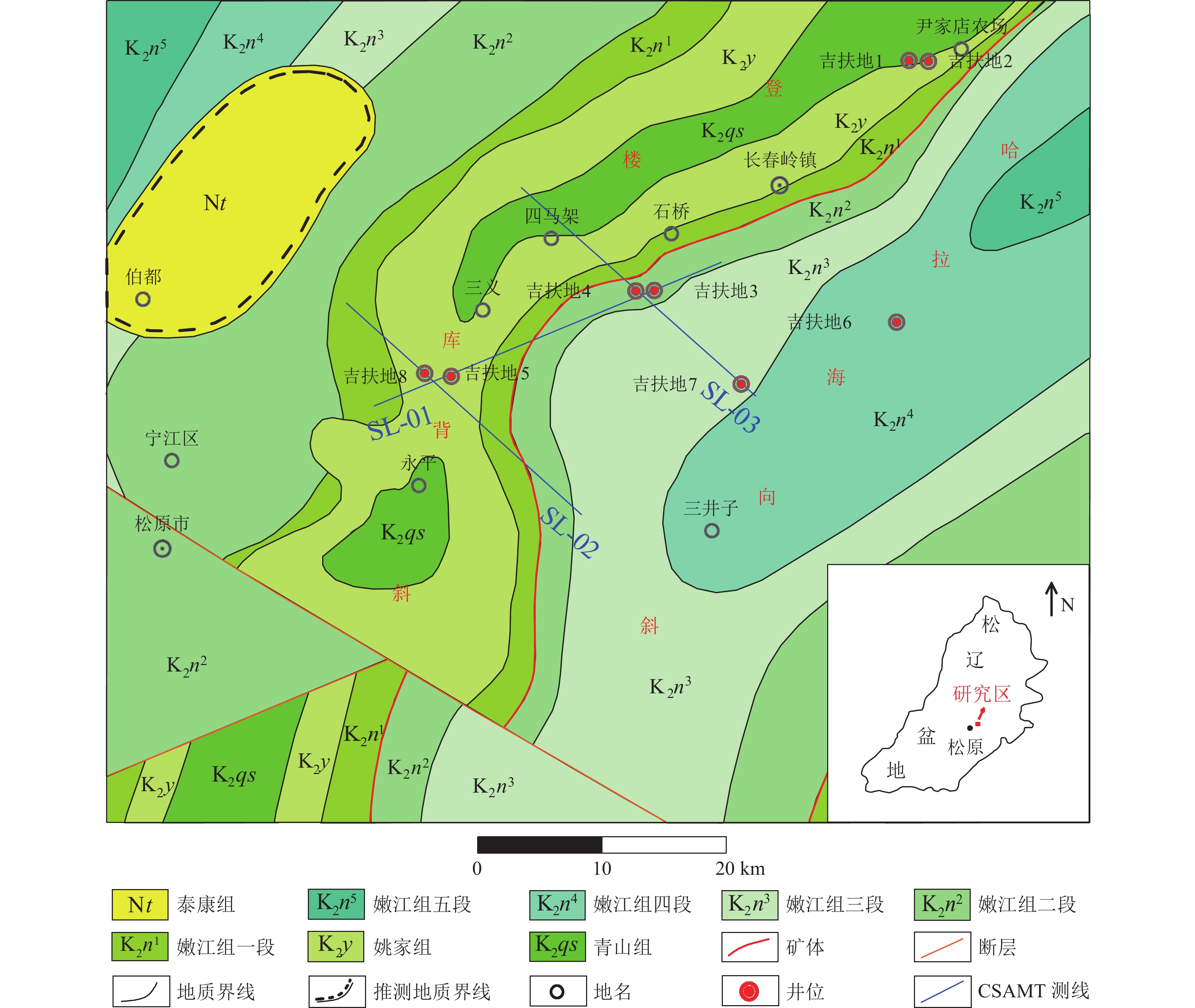
 下载:
下载:
